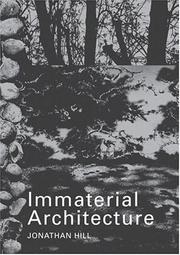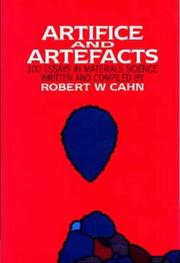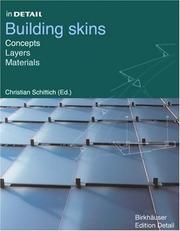| Listing 1 - 10 of 20 | << page >> |
Sort by
|
Book
ISBN: 3528088478 3322858502 Year: 1979 Publisher: Braunschweig Vieweg & Sohn
Abstract | Keywords | Export | Availability | Bookmark
 Loading...
Loading...Choose an application
- Reference Manager
- EndNote
- RefWorks (Direct export to RefWorks)
Building materials. Building technology --- Edvard Grunau --- sustainability --- Building materials. --- Building materials --- 691 --- bouw --- bouwmaterialen --- Architectural materials --- Architecture --- Building --- Building supplies --- Buildings --- Construction materials --- Structural materials --- Materials
Periodical
ISSN: 20758545 20758545 Year: 2009 Publisher: Moscow : OOO CNT "NanoStroitelstvo"
Abstract | Keywords | Export | Availability | Bookmark
 Loading...
Loading...Choose an application
- Reference Manager
- EndNote
- RefWorks (Direct export to RefWorks)
Nanotechnology --- Building materials --- Molecular technology --- Nanoscale technology --- Architectural materials --- Architecture --- Building supplies --- Buildings --- Construction materials --- Structural materials --- Materials --- nanocomposite --- nanostructured --- nanomaterials --- nanotechnology --- construction --- High technology --- Civil engineering. Building industry
Periodical
ISSN: 04652746 19883226 Year: 2014 Publisher: Madrid : Editorial CSIC Consejo Superior de Investigaciones Científicas,
Abstract | Keywords | Export | Availability | Bookmark
 Loading...
Loading...Choose an application
- Reference Manager
- EndNote
- RefWorks (Direct export to RefWorks)
Building materials --- Construction --- Research --- Periodicals. --- Matériaux --- Recherche --- Périodiques --- Building materials. --- Chemistry --- Chemical Engineering --- cement --- concrete --- durability --- corrosion --- restoration --- use of industrial waste and by-products in construction --- Architectural materials --- Architecture --- Building supplies --- Buildings --- Construction materials --- Structural materials --- Materials --- Engineering sciences. Technology --- Building materials. Building technology --- Materiales de construcción --- Materials de construcció --- Construcció --- Edificis --- Materials per a la construcció --- Productes de construcció

ISBN: 0415363233 9780415363235 0415363241 9780415363242 0203013611 9780203013618 9781134228263 9781134228300 9781134228317 Year: 2006 Publisher: New York : Routledge,
Abstract | Keywords | Export | Availability | Bookmark
 Loading...
Loading...Choose an application
- Reference Manager
- EndNote
- RefWorks (Direct export to RefWorks)
Architecture is expected to be solid, stable and reassuring-physically, socially and psychologically. Bound to each other, the architectural and the material are considered inseparable. Jonathan Hill, architect and architectural historian, argues that the immaterial is as important to architecture as the material and has as long a history and so 'Immaterial Architecture' explores the often conflicting forces that draw architecture towards either the material or the immaterial. The book discusses the pressures on architecture and the architectural profession to respectively be solid matter and solid practice, and considers concepts that align architecture with the immaterial, such as the superiority of ideas over matter, command of drawing, and design of spaces and surfaces. Focusing on immaterial architecture as the perceived absence of matter more than the actual absence of matter, Hill devises new means to explore the creativity of the user and the architect. Users decide whether architecture is immaterial, but architects, and any other architectural producers, create material conditions in which that decision can be made. 'Immaterial Architecture' advocates an architecture that fuses the immaterial and the material, and considers its consequences, challenging preconceptions about architecture, its practice, purpose, matter and use.
Architecture --- Immaterialism (Philosophy) --- Building materials. --- 72.01 --- Architectuurtheorie ; materialisme ; inmaterialisme --- Bouwmaterialen ; niet-tastbare elementen --- Architectural materials --- Building --- Building supplies --- Buildings --- Construction materials --- Structural materials --- Materials --- Immateriality (Philosophy) --- Concepts --- Idea (Philosophy) --- Idealism --- Philosophy --- Spiritualism (Philosophy) --- Substance (Philosophy) --- Universals (Philosophy) --- Philosophy. --- Architectuur ; theorie, filosofie, esthetica --- Immaterialism (Philosophy). --- Building materials --- architectuurfilosofie

ISBN: 075030152X 9780750301527 Year: 1991 Publisher: Bristol Philadelphia Institute of Physics
Abstract | Keywords | Export | Availability | Bookmark
 Loading...
Loading...Choose an application
- Reference Manager
- EndNote
- RefWorks (Direct export to RefWorks)
Building materials. --- Building materials --- #KVIV:BB --- 620 --- Architectural materials --- Architecture --- Building --- Building supplies --- Buildings --- Construction materials --- Structural materials --- Materials --- 620 Materials testing. Commercial materials. Power stations. Economics of energy --- Materials testing. Commercial materials. Power stations. Economics of energy --- Solid state physics --- Addresses, essays, lectures --- 620 Materiaaltesten. Commerciële materialen. Krachtcentrales. Energie-economie --- Materiaaltesten. Commerciële materialen. Krachtcentrales. Energie-economie
Book
ISBN: 0408000317 Year: 1977 Publisher: London Newnes-Butterworths
Abstract | Keywords | Export | Availability | Bookmark
 Loading...
Loading...Choose an application
- Reference Manager
- EndNote
- RefWorks (Direct export to RefWorks)
Building --- Building materials --- Physics --- 534 --- 534 Vibrations. Acoustics --- Vibrations. Acoustics --- Natural philosophy --- Philosophy, Natural --- Physical sciences --- Dynamics --- Architectural materials --- Architecture --- Building supplies --- Buildings --- Construction materials --- Structural materials --- Materials --- Architectural engineering --- Construction --- Construction science --- Engineering, Architectural --- Structural design --- Structural engineering --- Construction industry --- Design and construction --- 53 --- 53 Physics --- Building materials. Building technology --- Structural parts and elements of building --- building physics
Book
ISBN: 9781580935432 1580935435 Year: 2020 Publisher: New York The Monacelli Press
Abstract | Keywords | Export | Availability | Bookmark
 Loading...
Loading...Choose an application
- Reference Manager
- EndNote
- RefWorks (Direct export to RefWorks)
Architect, architectural historian and preservationist Françoise Bollack explores the use of traditional materials with contemporary forms and the corollary of contemporary materials applied to traditional forms and the blurring of the boundary between the two. Nineteen projects in the US, Europe, Japan, and New Zealand are examined. Among the featured architects are Kengo Kuma, architect of the Tokyo 2020 Olympic stadium, MVRDV, a highly regarded Dutch firm, and Lacaton & Vassal of Paris.
Construction --- Constructions --- Architecture --- Métaphore en architecture --- Matériaux --- Reconversion --- Architecture, Modern --- Building materials --- 691(03) --- 692.23 --- Gevelconstructies ; buitenmuren --- Gevelbekledingen --- Architectural materials --- Building --- Building supplies --- Buildings --- Construction materials --- Structural materials --- Materials --- Modern architecture --- Bouwmaterialen --- Constructie-elementen van gebouwen ; buitenmuren, gevels --- Building materials. Building technology --- architecture [discipline] --- Métaphore en architecture --- Matériaux

ISBN: 3764364653 Year: 2001 Publisher: München : Basel : Edition Detail ; Birkhäuser,
Abstract | Keywords | Export | Availability | Bookmark
 Loading...
Loading...Choose an application
- Reference Manager
- EndNote
- RefWorks (Direct export to RefWorks)
façades --- Architecture --- Facades --- Building materials --- Architectural design --- Façades --- Construction --- Design architectural --- Matériaux --- 692.2 --- 691 --- 692 --- Gevelconstructies ; buitenmuren ; details --- 692.23 --- Gevels --- Bouwmaterialen (architectuur) --- Buitenmuren --- Constructiedelen --- Constructie-elementen van gebouwen ; buitenmuren, gevels --- Building design --- Façades --- Matériaux --- façades and façade components --- Structural parts and elements of building --- Architectural fronts --- Fronts (Architecture) --- Exterior walls --- Architectural materials --- Building --- Building supplies --- Buildings --- Construction materials --- Structural materials --- Materials --- Design --- Structural design --- Details
Book
ISBN: 0747600112 Year: 1988 Publisher: Wokingham Van Nostrand Reinhold
Abstract | Keywords | Export | Availability | Bookmark
 Loading...
Loading...Choose an application
- Reference Manager
- EndNote
- RefWorks (Direct export to RefWorks)
Building design --- Architecture --- hedendaagse architectuur --- anno 1900-1999 --- Building. --- Structural engineering. --- Building materials. --- Construction --- Technique de la construction --- Matériaux --- Structural engineering --- Building materials --- Constructie ; van gebouwen ; schaal ; technieken --- 69(035) --- Architectural materials --- Building --- Building supplies --- Buildings --- Construction materials --- Structural materials --- Materials --- Engineering, Structural --- Structures, Engineering of --- Engineering --- Architectural engineering --- Construction science --- Engineering, Architectural --- Structural design --- Construction industry --- Bouwwezen. Constructie ; handboeken --- Design and construction --- Matériaux --- Modern [style or period] --- architecture [object genre]
Book
ISBN: 9781859466452 1859466451 9780429346712 0429346719 9781000701555 1000701557 9781000700336 100070033X 9781000700947 1000700941 Year: 2016 Publisher: Newcastle upon Tyne RIBA Publishing
Abstract | Keywords | Export | Availability | Bookmark
 Loading...
Loading...Choose an application
- Reference Manager
- EndNote
- RefWorks (Direct export to RefWorks)
The construction industry operates within a linear economy of make, use, dispose. Buildings are stripped out and torn down with astonishing regularity while new buildings are constructed from hard-won virgin materials. But raw materials are becoming scarce, and the demands for them are exploiting fragile ecosystems, even as the global demand for resources continues to rise. Policy makers and organisations are beginning to look for a more regenerative, circular economy model. The construction industry demands over half the world's extracted materials and generates around a third of the total waste generated in the EU, making it a prime candidate for applying the circular economy. Yet there has been little focus on how construction industry professionals and their clients can contribute towards the movement. Drawing on illustrative methods and examples, Building Revolutions explains how the principles of a circular economy can be applied to the built environment where resources are kept in use and their value retained. 0The book describes how buildings and materials can be reused or salvaged to extend their life and proposes ways new business models can be applied to reduce capital and lifecycle costs, providing a positive architectural legacy for future generations.
Sustainable construction --- Sustainable buildings --- Buildings --- Building materials --- 72:574 --- Architectuur en ecologie --- Duurzame architectuur ; materialen --- Bouwmaterialen ; recyclage --- Ontwerptheorie ; over hergebruik ; recyclage --- Architectural materials --- Architecture --- Building --- Building supplies --- Construction materials --- Structural materials --- Materials --- Adaptive reuse of buildings --- Ecologically sustainable buildings --- Environmentally sustainable buildings --- Green buildings (Green technology) --- Sustainable development --- Green construction --- Sustainable engineering --- Remodeling for other use --- Adaptive reuse --- Conservation and restoration --- circulaire economie --- circulair bouwen --- recyclage --- bouwmaterialen --- duurzaamheid
| Listing 1 - 10 of 20 | << page >> |
Sort by
|

 Search
Search Feedback
Feedback About
About Help
Help News
News